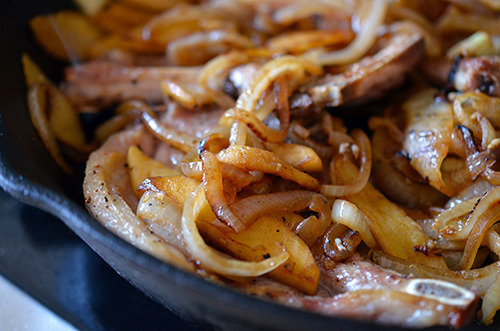Smothered Pork Chops With Cider and Apples
Serve smothered chops with a starch to soak up the rich gravy. Simple egg noodles were the test kitchen favorite, but rice or mashed potatoes also taste great.
Serves 4
3 ounces (about 3 slices) bacon, cut into 1/4-inch pieces
2 tablespoons unbleached all-purpose flour
1 3/4 cups apple cider
vegetable oil
4 bone-in, rib-end pork chops 1/2 to 3/4 inch thick
ground black pepper
1 medium yellow onion halved pole to pole and sliced thin
table salt
2 tablespoons water
2 medium cloves of garlic, pressed through garlic press or minced (about 2 teaspoons)
1 teaspoon minced fresh thyme
2 bay leaves
1 tablespoon minced fresh parsley
1 large or 2 small Granny Smith apples, peeled, cored, and cut into 3/8-inch wedges
1. Fry bacon in small saucepan over medium heat, stirring occasionally, until lightly browned, 8 to 10 minutes. Using slotted spoon, transfer bacon to paper towel-lined plate, leaving fat in saucepan (you should have 2 tablespoons bacon fat; if not, supplement with vegetable oil). Reduce heat to medium-low and gradually whisk flour into fat until smooth. Cook, whisking frequently, until mixture is light brown, about the color of peanut butter, about 5 minutes. Whisk in apple cider in slow, steady stream; increase heat to medium-high and bring to boil, stirring occasionally; cover and set aside off heat.
2. Heat 1-tablespoon oil in 12-inch skillet over high heat until smoking, about 3 minutes. Meanwhile, dry pork chops with paper towels and sprinkle with 1/2-teaspoon pepper. Brown chops in single layer until deep golden on first side, about 3 minutes. Flip chops and cook until browned on second side, about 3 minutes longer. Transfer chops to large plate and set aside.
3. Reduce heat to medium and add 1 tablespoon oil, onions, apples, 1/2 teaspoon salt, and water to now-empty skillet. Using wooden spoon, scrape browned bits on pan bottom and cook, stirring frequently, until onions are softened and browned around the edges, about 5 minutes. Stir in garlic and thyme and cook until fragrant, about 30 seconds longer. Return chops to skillet in single layer, covering chops with onions. Pour in warm sauce and any juices collected from pork; add bay leaves. Cover, reduce heat to low, and simmer until pork is tender and paring knife inserted into chops meets very little resistance, about 30 minutes.
4. Transfer chops to warmed serving platter and tent with foil. Increase heat to medium-high and simmer sauce rapidly, stirring frequently, until thickened to gravy-like consistency, about 5 minutes. Discard bay leaves, stir in parsley, and adjust seasonings with salt and pepper. Cover chops with sauce, sprinkle with reserved bacon, and serve immediately.






